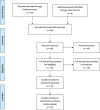Systematic Review and Meta-Analysis of the Clinical Evidence on the Use of Autologous Matrix-Induced Chondrogenesis in the Knee
- PMID: 31508990
- PMCID: PMC8808829
- DOI: 10.1177/1947603519870846
Systematic Review and Meta-Analysis of the Clinical Evidence on the Use of Autologous Matrix-Induced Chondrogenesis in the Knee
Abstract
Objective: A systematic review and meta-analysis of Autologous Matrix-Induced Chondrogenesis (AMIC®) outcomes for grade III/IV chondral and osteochondral lesions of the knee treated with Chondro-Gide®.
Design: Studies with a minimum follow-up of 1 year providing clinical results of AMIC repair in the knee were included based on PRISMA guidelines (Preferred Reporting Items for Systematic Reviews and Meta-Analyses). Methodological quality was assessed by the modified Coleman Methodology Score (mCMS). The meta-analysis was comparing pain VAS (Visual Analog Scale), Lysholm score, and IKDC score (International Knee Documentation Committee) between baseline and follow-up after 1 or 2 years and after >3 years.
Results: Twelve studies (375 patients) were included. The mCMS demonstrated a suboptimal study design (ranking between 52 and 80). The mean age was 36.2 years (14-70 years). The mean defect size was 4.24 cm2 (0.8-22 cm2). The results from the random effects model indicated a clinically significant (P < 0.05) improvement of pain VAS from baseline to follow-up at year 1 to 2 of -4.02(confidence interval -4.37; -3.67), still significant after 3 years. Lysholm score at year 1 or 2 improved significantly and remained highly significant after 3 years. IKDC score showed highly significant improvement of 32.61 between 1 and 2 years versus baseline values maintained after 3 years.
Conclusions: The AMIC procedure significantly improved the clinical status and functional scoring versus preoperative values. Evidence was obtained in a non-selected patient population, corresponding to real-life treatment of knee chondral and osteochondral defects. The evidence is sufficient to recommend AMIC in this indication.
Keywords: Chondro-Gide®; autologous matrix-induced chondrogenesis (AMIC®); cartilage; knee; microfracture.
Conflict of interest statement
Figures











References
-
- Frank RM, Cotter EJ, Nassar I, Cole B. Failure of bone marrow stimulation techniques. Sports Med Arthrosc. 2017;25(1_suppl):2-9. - PubMed
-
- Bert JM. Abandoning microfracture of the knee: has the time come? Arthroscopy. 2015;31(3):501-5. - PubMed
-
- Mithoefer K, McAdams T, Williams RJ, Kreuz PC, Mandelbaum BR. Clinical efficacy of the microfracture technique for articular cartilage repair in the knee: an evidence-based systematic analysis. Am J Sports Med. 2009;37(10):2053-63. - PubMed
-
- Goyal D, Keyhani S, Lee EH, Hui JH. Evidence-based status of microfracture technique: a systematic review of level I and II studies. Arthroscopy. 2013;29(9):1579-88. - PubMed
Publication types
MeSH terms
Substances
LinkOut - more resources
Full Text Sources
Medical

